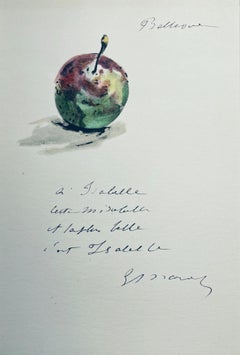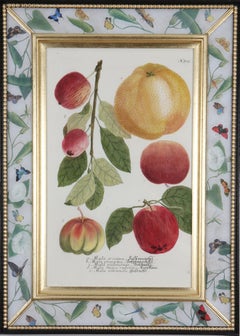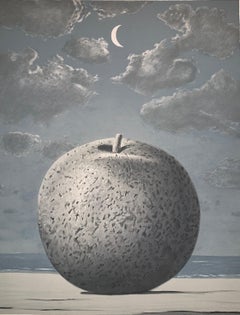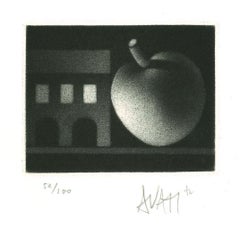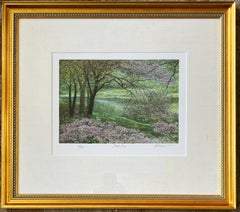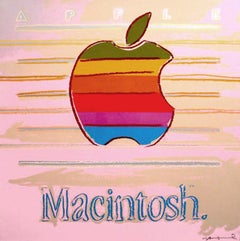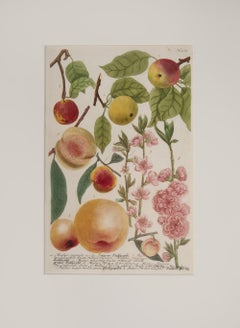Apple Figurative Prints
to
1
3
2
1
2
1
Overall Width
to
Overall Height
to
2
1
1
1
1
1
1
1
1
1
1
1
6
1
1
2
1
1
6
3
281
26,760
14,672
10,623
9,023
7,724
6,939
4,592
4,159
2,388
2,046
1,934
1,844
1,626
1,459
1,432
1,424
1,407
1,285
1,205
5
1
1
1
1
2
3
5
4
Art Subject: Apple
New York, New York, vintage 1980s poster (hand signed and inscribed by Don Nice)
By Don Nice
Located in New York, NY
Don Nice
New York, New York (hand signed and inscribed by Don Nice), 1984
Rare offset lithograph poster (signed and inscribed from Don Nice to Dick Polich)
Signed and inscribed in gr...
Category
1980s Pop Art Figurative Prints
Materials
Lithograph, Offset
Manet, Composition, Édouard Manet, Letters with Aquarelles (after)
Located in Southampton, NY
Lithograph and stencil on vélin Foreign Affairs paper mounted on Foreign Affairs museum board, as issued . Unsigned and unnumbered, as issued. Good Condition. Notes: From the folio, Édouard Manet, Letters with Aquarelles, 1944. Published by Pantheon Books, New York; rendered and printed by Raymond and...
Category
1940s Impressionist Figurative Prints
Materials
Lithograph
$716 Sale Price
20% Off
Johann Weinmann: c.18th Engravings of Fruit in Decalcomania Frames
Located in Richmond, GB
Hand-coloured mezzotint engravings from: ""Phytanthoza Iconographia"", c1739, presented in hand-made parcel-gilt, ebonised and decalcomania frames.
Johann Weinmann (1683-1741), a G...
Category
18th Century Figurative Drawings and Watercolors
Materials
Watercolor, Mezzotint
Souvenir de Voyage - 20th Century, Surrealist, Lithograph, Figurative Print
Located in Sint-Truiden, BE
Color lithograph after the 1952 oil on canvas by René Magritte, printed signature of Magritte and numbered from the edition of 275.
The lithograph features the dry stamps of the Mag...
Category
20th Century Surrealist Figurative Prints
Materials
Lithograph
Apple Orchard
Located in San Francisco, CA
This artwork titled "Apple Orchard" 1998, is a color off set lithograph by British/American artist Pati Bannister, 1929-2013. It is hand signed, titled a...
Category
Late 20th Century Romantic Figurative Prints
Materials
Lithograph
Apple and House - Etching on Paper by Mario Avati - 1970s
By Mario Avati
Located in Roma, IT
Apple and House is original etching on paper, realized by the French artist and print-maker master Mario Avati (1921-2009).
Hand-signed on the lower right and numbered on the lower ...
Category
1970s Figurative Prints
Materials
Etching
The Pomacae - Lithograph by Vincenzo Tenore - 1870s
Located in Roma, IT
Lithograph hand watercolored.
Plate from "Atlante di Botanica popolare ossia Illustrazione di Piante Notevoli di ogni famiglia" (Atlas of popular botany or illustration of notable p...
Category
1870s Modern Figurative Prints
Materials
Lithograph
Breakfast with Miss Julie, 2022
Located in Greenwich, CT
Breakfast with Miss Julie is an archival digital pigment print on canvas, signed ‘Kondakova’ in the right corner and numbered 88/295 in the left corner. From the total edition of 325...
Category
21st Century and Contemporary Contemporary Prints and Multiples
Materials
Canvas, Digital Pigment
Pojdziesz Ponad Sadem - Vintage Poster - 1974
Located in Roma, IT
Pojdziesz Ponad Sadem - Vintage Poster is a vintage poster realized by Unknown Artist, in 1974s.
Mixed colored offset print.
The artwork represented a Polish film poster. Director...
Category
1970s Contemporary Figurative Prints
Materials
Photogravure
Related Items
Untitled (Fantastic Scene)
Located in San Francisco, CA
This artwork "Untitled, Fantastic Scene" c.1975 is an original color etching with aquatint on wove paper by American surrealist artist Michael Bowen, 1937-2009. It is hand signed in pencil by the artist. The plate mark (image) size is 14.85 x 18 inches, sheet size is 21.5 x 26 inches. It is in excellent condition, has never been framed.
About the subject:
Nowhere is the intertwining of metaphysical, biographic and social narratives more evident than in the Café Life series painted in the 1980’s. Though the “series” was done in the 80’s, the pieces really revive the spirit of the Beat café scene, which began in the mid-1950’s and which was so instrumental to the particular spiritual and social vibe of the counter culture. And his Café Life observations continue over his artist life with scenes, such as the ones here, from Los Angles, Bolinas, Mexico and Italy.
About the artist:
Michael Bowen (December 8, 1937 – March 7, 2009) was an American fine artist known as one of the co-founders of the late 20th and 21st century Visionary art movements. His works include paintings on canvas and paper, 92 intaglio etchings based on Jungian psychology, assemblage, bronze sculpture, collage, and handmade art books. An icon of the American Beat Generation and the 1960s counterculture, Bowen is also known for his role in inspiring and organizing the first Human Be-In in San Francisco. Chronicled in books and periodicals reflecting on the turbulent 1960s, Bowen's historical impact on both the literary and visual art worlds is well documented. He remains influential among avant-garde art circles around the world. He started his art career at age 17, when he joined the American installation artist Ed Kienholz in his Los Angeles studio. There he met and joined with other influential Beat Generation artists including Wallace Berman, John Altoon, and Dennis Hopper. Bowen participated in the construction of the Ferus Gallery and Now Gallery created by Ed Kienholz and curated by Walter Hopps. Bowen attended the Chouinard Art Institute for several years during his formative artistic experiences in Los Angeles. In the late 50s and early 60s, Bowen continued his spiritual training and research. He investigated and practiced a variety of occult topics, Eastern philosophies, and mysticism, and his artwork reflected these themes. Bowen is often referred to as a mystic artist. As a lifelong student of the Bhagavad-Gita, Bowen's entire career has emulated the spiritual warrior archetype of Arjuna, fighting for the Bill of Rights of the United States Constitution. Michael Bowen moved to San Francisco in the late 1950s, and along with fellow artist comrades Arthur Monroe...
Category
Late 20th Century Surrealist Figurative Prints
Materials
Etching, Aquatint
Duck Pond
Located in San Francisco, CA
Artist: Harold Altman (American, 1924-2003)
Title: Duck Pond
Year: circa 1980
Medium: Original color lithograph
Edition: 285. This one: 29/285 in pencil
Paper: Arches
Image size...
Category
Late 20th Century American Impressionist Landscape Prints
Materials
Lithograph
La Cote d'Azur
Located in San Francisco, CA
This artwork titled "La Cote d'Azur" c.1980, is an original colors lithograph on watermarked Arches paper by noted French artist Jean Claude Picot, 1933-2020. It is hand signed and ...
Category
Late 20th Century Impressionist Landscape Prints
Materials
Lithograph
Double Faces, Variant #1
Located in San Francisco, CA
This artwork titled "Double Faces" c.1975 is an original color etching with aquatint on wove paper by American surrealist artist Michael Bowen, 1937-2009. It is hand signed with initials in pencil by the artist. The plate mark (image) size is 21.75 x 17.5 inches, sheet size is 29.25 x 20.75 inches. It is in excellent condition, has never been framed.
About the subject:
Nowhere is the intertwining of metaphysical, biographic and social narratives more evident than in the Café Life series painted in the 1980’s. Though the “series” was done in the 80’s, the pieces really revive the spirit of the Beat café scene, which began in the mid-1950’s and which was so instrumental to the particular spiritual and social vibe of the counter culture. And his Café Life observations continue over his artist life with scenes, such as the ones here, from Los Angles, Bolinas, Mexico and Italy.
About the artist:
Michael Bowen (December 8, 1937 – March 7, 2009) was an American fine artist known as one of the co-founders of the late 20th and 21st century Visionary art movements. His works include paintings on canvas and paper, 92 intaglio etchings based on Jungian psychology, assemblage, bronze sculpture, collage, and handmade art books. An icon of the American Beat Generation and the 1960s counterculture, Bowen is also known for his role in inspiring and organizing the first Human Be-In in San Francisco. Chronicled in books and periodicals reflecting on the turbulent 1960s, Bowen's historical impact on both the literary and visual art worlds is well documented. He remains influential among avant-garde art circles around the world. He started his art career at age 17, when he joined the American installation artist Ed Kienholz in his Los Angeles studio. There he met and joined with other influential Beat Generation artists including Wallace Berman, John Altoon, and Dennis Hopper. Bowen participated in the construction of the Ferus Gallery and Now Gallery created by Ed Kienholz and curated by Walter Hopps. Bowen attended the Chouinard Art Institute for several years during his formative artistic experiences in Los Angeles. In the late 50s and early 60s, Bowen continued his spiritual training and research. He investigated and practiced a variety of occult topics, Eastern philosophies, and mysticism, and his artwork reflected these themes. Bowen is often referred to as a mystic artist. As a lifelong student of the Bhagavad-Gita, Bowen's entire career has emulated the spiritual warrior archetype of Arjuna, fighting for the Bill of Rights of the United States Constitution. Michael Bowen moved to San Francisco in the late 1950s, and along with fellow artist comrades Arthur Monroe...
Category
Late 20th Century Surrealist Figurative Prints
Materials
Etching, Aquatint
Parc Monceau, Paris
Located in San Francisco, CA
Artist: Harold Altman (American, 1924-2003)
Title: Parc Monceau, Paris
Year: c.1985
Medium: Color lithograph
Edition: Inscribed H.C. (Hors Commerce) ...
Category
Late 20th Century American Impressionist Landscape Prints
Materials
Lithograph
untitled, original
By Paul Colin
Located in Belgrade, MT
This piece is a limited edition, pencil signed by the artist on the print and in the plate. It is part of my private collection of artists from the School of Paris era. It is in very...
Category
Mid-20th Century Surrealist Figurative Prints
Materials
Engraving, Lithograph
Les bleus de Barcelone
Located in OPOLE, PL
This work will be exhibited at Art on Paper NYC, September 4–7, 2025.
–-
Technique: Aquatint and etching
Paper: Gourbeyre wove paper with watermark “Au Vent d’Arles”
Edition: 73/75...
Category
20th Century Modern Figurative Prints
Materials
Etching
Dust Time, large lithograph
By John Maxon
Located in San Francisco, CA
Artist: John Maxon (American, born 1947)
Title: Dust Time
Year: 1993
Medium: Color lithograph
Edition: Numbered 146/210
Paper: Arches
Image size: 26.5 x 39.75 inches
Paper size: 31.5 x 44 inches
Signature: Hand signed in pencil by the artist
Condition: Excellent, has never been framed
About the artist.
Coming from a very western tradition in Wyoming, John Maxon developed an expansive view of nature . Moving eventually to the San Francisco Bay area, John's delight in the effects of light and color led him to the decision to become an artist at the young age of 15. His natural ability was encouraged, and at 16 he began figurative art classes with Howard Brodie, the artist well known for his WWII correspondence, drawings and the Watergate trial drawings.
Education
San Francisco Art Institute
B.A., Painting, San Jose State University
M.F.A., Painting, University of California, Davis
Stanford University, Palo Alto, California
Cabrillo College, Aptos, California
Selected Solo Exhibitions
2018
Gallery Panza Verde – Antigua Guatemala, Guatemala
2015
Desert Art Collection - Palm Desert California
2015
Galeria Antigua – Antigua, Guatemala
2014
Galeria Panza Verde – Antigua, Guatemala
2008
Linda Durnell Gallery – Los Gatos, California
2006
Linda Durnell Gallery – Los Gatos, California
2005
Robert Allen Fine Art Gallery – Sausalito, California
2004
Ellis West Gallery – Durango, Colorado
2002
Ellis West Gallery – Durango, Colorado
2001
Robert Allen Fine Art Gallery – Sausalito, California
1997
Stanford University Faculty Club – Stanford, California
Selected Group Exhibitions
2018
Chemers Art Gallery – Los Angeles, California
2009, 2010, 2016, 2017 & 2018
Robert Allen Fine Art – Sausalito, California
2017 Christopher Hill Gallery - St Helena, California
2013 / 19
Gallery North - Carmel, California
2015
Desert Art Collection - Palm Desert, California
2014
Paul Scott Gallery - Bend, Oregon
2014
Christopher Hill Gallery Healdsberg, California
2013
Firehouse Art Center - Pleasanton, Ca. 2013
2011 - 2013
Robert Allen Fine Art – Sausalito, California
2010 - 2012
Susan Street Gallery – Solano Beach, California
2010 (Awarded 1st place) and 2012
“Contemporary Landscape Painters of California” – Awarded 1st Place
2011 - 2012
Salisbury Fine Art – Avila Beach, California
2010
Bryant Street Gallery – Palo Alto, California
2009
Museum Art and History – Santa Cruz, California
2008
Cabrillo College – Aptos, California
2006
Christopher Hill Gallery – St. Helena, California
2005
Fort Lewis College – Durango, Colorado
2001
St. Supery Winery & Fine Art Gallery, Napa California
2001
Napa Valley Wine Auction – St. Helena, California
1997
West Coast Painting and Sculpture – Ocean Side, California
1997
Wolk Gallery – St. Helena, California
Selected Museum Collections
Interior Museum, Department of the Interior, Washington D. C.
Santa Cruz County Art Museum – Santa Cruz, California
University of California – Berkeley, California
University of California – Davis, California
Napa Valley Art...
Category
Late 20th Century American Impressionist Landscape Prints
Materials
Lithograph
David Shrigley - Fight the Fucking Asshole Fuckwit Bastards
Located in London, GB
80 x 60 cm
Off-set lithography
Printed on 200g Munken Lynx paper
Narayana Press in Denmark
David Shrigley is a British visual artist known for his distinctive, whimsical, and often ...
Category
2010s Contemporary Still-life Prints
Materials
Lithograph, Offset
$478
H 31.5 in W 23.63 in
19th century color lithograph figures cemetery willow tree memorial headstone
Located in Milwaukee, WI
The present hand-colored lithograph was produced as part of the funeral and mourning culture in the United States during the 19th century. Images like this were popular as ways of remembering loved ones, an alternative to portraiture of the deceased. This lithograph shows a man, woman and child in morning clothes next to an urn-topped stone monument. Behind are additional putto-topped headstones beneath weeping willows, with a steepled church beyond. The monument contains a space where a family could inscribe the name and death dates of a deceased loved one. In this case, it has been inscribed to a young Civil War soldier:
William W. Peabody
Died at Fairfax Seminary, VA
December 18th, 1864
Aged 18 years
The young Mr. Peabody probably died in service for the Union during the American Civil War. Farifax Seminary was a Union hospital and military headquarters in Alexandria, Virginia. The hospital served nearly two thousand soldiers during the war time. Five hundred were also buried on the Seminary's grounds.
13.75 x 9.5 inches, artwork
23 x 19 inches, frame
Published before 1864
Inscribed bottom center "Lith. & Pub. by N. Currier. 2 Spruce St. N.Y."
Framed to conservation standards using 100 percent rag matting and TruVue Conservation Clear glass, housed in a gold gilded moulding.
Nathaniel Currier was a tall introspective man with a melancholy nature. He could captivate people with his piercing stare or charm them with his sparkling blue eyes. Nathaniel was born in Roxbury, Massachusetts on March 27th, 1813, the second of four children. His parents, Nathaniel and Hannah Currier, were distant cousins who lived a humble yet spartan life. When Nathaniel was eight years old, tragedy struck. Nathaniel’s father unexpectedly passed away leaving Nathaniel and his eleven-year-old brother Lorenzo to provide for the family. In addition to their mother, Nathaniel and Lorenzo had to care for six-year-old sister Elizabeth and two-year-old brother Charles. Nathaniel worked a series of odd jobs to support the family, and at fifteen, he started what would become a life-long career when he apprenticed in the Boston lithography shop of William and John Pendleton.
A Bavarian gentleman named Alois Senefelder invented lithography just 30 years prior to young Nat Currier’s apprenticeship. While under the employ of the brothers Pendleton, Nat was taught the art of lithography by the firm’s chief printer, a French national named Dubois, who brought the lithography trade to America.
Lithography involves grinding a piece of limestone flat and smooth then drawing in mirror image on the stone with a special grease pencil. After the image is completed, the stone is etched with a solution of aqua fortis leaving the greased areas in slight relief. Water is then used to wet the stone and greased-ink is rolled onto the raised areas. Since grease and water do not mix, the greased-ink is repelled by the moisture on the stone and clings to the original grease pencil lines. The stone is then placed in a press and used as a printing block to impart black on white images to paper.
In 1833, now twenty-years old and an accomplished lithographer, Nat Currier left Boston and moved to Philadelphia to do contract work for M.E.D. Brown, a noted engraver and printer. With the promise of good money, Currier hired on to help Brown prepare lithographic stones of scientific images for the American Journal of Sciences and Arts. When Nat completed the contract work in 1834, he traveled to New York City to work once again for his mentor John Pendleton, who was now operating his own shop located at 137 Broadway. Soon after the reunion, Pendleton expressed an interest in returning to Boston and offered to sell his print shop to Currier. Young Nat did not have the financial resources to buy the shop, but being the resourceful type he found another local printer by the name of Stodart. Together they bought Pendleton’s business.
The firm ‘Currier & Stodart’ specialized in "job" printing. They produced many different types of printed items, most notably music manuscripts for local publishers. By 1835, Stodart was frustrated that the business was not making enough money and he ended the partnership, taking his investment with him. With little more than some lithographic stones, and a talent for his trade, twenty-two year old Nat Currier set up shop in a temporary office at 1 Wall Street in New York City. He named his new enterprise ‘N. Currier, Lithographer’
Nathaniel continued as a job printer and duplicated everything from music sheets to architectural plans. He experimented with portraits, disaster scenes and memorial prints, and any thing that he could sell to the public from tables in front of his shop. During 1835 he produced a disaster print Ruins of the Planter's Hotel, New Orleans, which fell at two O’clock on the Morning of the 15th of May 1835, burying 50 persons, 40 of whom Escaped with their Lives. The public had a thirst for newsworthy events, and newspapers of the day did not include pictures. By producing this print, Nat gave the public a new way to “see” the news. The print sold reasonably well, an important fact that was not lost on Currier.
Nat met and married Eliza Farnsworth in 1840. He also produced a print that same year titled Awful Conflagration of the Steamboat Lexington in Long Island Sound on Monday Evening, January 18, 1840, by which melancholy occurrence over One Hundred Persons Perished. This print sold out very quickly, and Currier was approached by an enterprising publication who contracted him to print a single sheet addition of their paper, the New York Sun. This single page paper is presumed to be the first illustrated newspaper ever published.
The success of the Lexington print launched his career nationally and put him in a position to finally lift his family up. In 1841, Nat and Eliza had their first child, a son they named Edward West Currier. That same year Nat hired his twenty-one year old brother Charles and taught him the lithography trade, he also hired his artistically inclined brother Lorenzo to travel out west and make sketches of the new frontier as material for future prints. Charles worked for the firm on and off over the years, and invented a new type of lithographic crayon which he patented and named the Crayola. Lorenzo continued selling sketches to Nat for the next few years.
In 1843, Nat and Eliza had a daughter, Eliza West Currier, but tragedy struck in early 1847 when their young daughter died from a prolonged illness. Nat and Eliza were grief stricken, and Eliza, driven by despair, gave up on life and passed away just four months after her daughter’s death.
The subject of Nat Currier’s artwork changed following the death of his wife and daughter, and he produced many memorial prints and sentimental prints during the late 1840s. The memorial prints generally depicted grief stricken families posed by gravestones (the stones were left blank so the purchasers could fill in the names of the dearly departed). The sentimental prints usually depicted idealized portraits of women and children, titled with popular Christian names of the day.
Late in 1847, Nat Currier married Lura Ormsbee, a friend of the family. Lura was a self-sufficient woman, and she immediately set out to help Nat raise six-year-old Edward and get their house in order. In 1849, Lura delivered a son, Walter Black Currier, but fate dealt them a blow when young Walter died one year later. While Nat and Lura were grieving the loss of their new son, word came from San Francisco that Nat’s brother Lorenzo had also passed away from a brief illness. Nat sank deeper into his natural quiet melancholy. Friends stopped by to console the couple, and Lura began to set an extra place at their table for these unexpected guests. She continued this tradition throughout their lives.
In 1852, Charles introduced a friend, James Merritt Ives, to Nat and suggested he hire him as a bookkeeper. Jim Ives was a native New Yorker born in 1824 and raised on the grounds of Bellevue Hospital where his father was employed as superintendent. Jim was a self-trained artist and professional bookkeeper. He was also a plump and jovial man, presenting the exact opposite image of his new boss.
Jim Ives met Charles Currier through Caroline Clark, the object of Jim’s affection. Caroline’s sister Elizabeth was married to Charles, and Caroline was a close friend of the Currier family. Jim eventually proposed marriage to Caroline and solicited an introduction to Nat Currier, through Charles, in hopes of securing a more stable income to support his future wife.
Ives quickly set out to improve and modernize his new employer’s bookkeeping methods. He reorganized the firm’s sizable inventory, and used his artistic skills to streamline the firm’s production methods. By 1857, Nathaniel had become so dependent on Jims’ skills and initiative that he offered him a full partnership in the firm and appointed him general manager. The two men chose the name ‘Currier & Ives’ for the new partnership, and became close friends.
Currier & Ives produced their prints in a building at 33 Spruce Street where they occupied the third, fourth and fifth floors. The third floor was devoted to the hand operated printing presses that were built by Nat's cousin, Cyrus Currier, at his shop Cyrus Currier & Sons in Newark, NJ. The fourth floor found the artists, lithographers and the stone grinders at work. The fifth floor housed the coloring department, and was one of the earliest production lines in the country. The colorists were generally immigrant girls, mostly German, who came to America with some formal artistic training. Each colorist was responsible for adding a single color to a print. As a colorist finished applying their color, the print was passed down the line to the next colorist to add their color. The colorists worked from a master print displayed above their table, which showed where the proper colors were to be placed. At the end of the table was a touch up artist who checked the prints for quality, touching-in areas that may have been missed as it passed down the line. During the Civil War, demand for prints became so great that coloring stencils were developed to speed up production.
Although most Currier & Ives prints were colored in house, some were sent out to contract artists. The rate Currier & Ives paid these artists for coloring work was one dollar per one hundred small folios (a penny a print) and one dollar per one dozen large folios. Currier & Ives also offered uncolored prints to dealers, with instructions (included on the price list) on how to 'prepare the prints for coloring.' In addition, schools could order uncolored prints from the firm’s catalogue to use in their painting classes.
Nathaniel Currier and James Merritt Ives attracted a wide circle of friends during their years in business. Some of their more famous acquaintances included Horace Greeley, Phineas T. Barnum, and the outspoken abolitionists Rev. Henry Ward, and John Greenleaf Whittier (the latter being a cousin of Mr. Currier).
Nat Currier and Jim Ives described their business as "Publishers of Cheap and Popular Pictures" and produced many categories of prints. These included Disaster Scenes, Sentimental Images, Sports, Humor, Hunting Scenes, Politics, Religion, City and Rural Scenes, Trains, Ships, Fire Fighters, Famous Race Horses, Historical Portraits, and just about any other topic that satisfied the general public's taste. In all, the firm produced in excess of 7500 different titles, totaling over one million prints produced from 1835 to 1907.
Nat Currier retired in 1880, and signed over his share of the firm to his son Edward. Nat died eight years later at his summer home 'Lion’s Gate' in Amesbury, Massachusetts. Jim Ives remained active in the firm until his death in 1895, when his share of the firm passed to his eldest son, Chauncey.
In 1902, faced will failing health from the ravages of Tuberculosis, Edward Currier sold his share of the firm to Chauncey Ives...
Category
Mid-19th Century Romantic Figurative Prints
Materials
Watercolor, Lithograph
19th century color lithograph watercolor landscape figurative animal print
Located in Milwaukee, WI
The present hand-colored lithograph presents the viewer with a hunting scene in a picturesque landscape. In the foreground, a man approaches two partridges as his two pointers prepare to flush them out. Beyond, a white fence draws our eyes to the homestead in the distance. Images like this one show how people in the United States were trying to identify themselves as a new nation in the North American landscape - as separate from their European counterparts but with similar similar and specific wildlife and magesties of nature. It also identifies hunting in this landscape as an American pastime.
9.25 x 12.5 inches, artwork
18.38 x 22 inches, frame
Entitled bottom center "Partridge Shooting...
Category
Mid-19th Century Romantic Figurative Prints
Materials
Watercolor, Lithograph
Composition Of Diodora - Original Lithograph by Bruno Capacci - 1950
Located in Roma, IT
Composition Of Diodora is an original lithograph realized by Bruno Capacci in 1950.
The artwork is part of an edition of 500 specimens by "La nef d'arge...
Category
1950s Surrealist Figurative Prints
Materials
Lithograph
$358
H 14.73 in W 9.85 in D 0.04 in
Previously Available Items
Apple, from the Ads Portfolio, 1985
By Andy Warhol
Located in Palo Alto, CA
Andy Warhol’s Apple 1985 screenprint, is a work from Warhol’s Ads series and acts as a commentary on the power of technology and advertising. The famous l...
Category
1980s Pop Art Figurative Prints
Materials
Screen
Apples
Located in London, GB
WEINMANN, Johann Wilhelm.
Apples
Hieronymous Lenzius, Regensburg, [1735]-1737-1745.
attractive plates, being one of the earliest examples of colour printing.
Johann Weinmann (168...
Category
Early 18th Century Naturalistic Figurative Prints
Materials
Laid Paper, Mezzotint
Apples
Located in London, GB
WEINMANN, Johann Wilhelm.
Apples
Hieronymous Lenzius, Regensburg, [1735]-1737-1745.
attractive plates, being one of the earliest examples of colour printing.
Johann Weinmann (16...
Category
Mid-18th Century Naturalistic Figurative Prints
Materials
Laid Paper, Mezzotint
François-Xavier Lalanne (1927-2008) the Apple -2003
Located in Saint Ouen, FR
François-Xavier Lalanne (1927-2008) the Apple, 2003
Techniques : heliogravure on paper, hand signed in pencil by François Xavier Lalanne, in perfect condition
Dimensions of the pape...
Category
Early 2000s Figurative Prints
Materials
Paper
H 14.97 in W 11.03 in D 0.4 in
Johann Weinmann: c.18th Engraving of Fruit in a Decalcomania Frame.
Located in Richmond, GB
Price is for each framed print (several available).
Hand-coloured mezzotint engraving from: ""Phytanthoza Iconographia"", c1739, presented in a hand-made parcel-gilt, ebonised and ...
Category
18th Century Figurative Prints
Materials
Watercolor, Mezzotint

